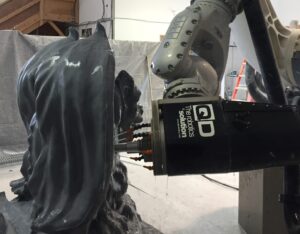
Home » Carve » Experience » Getting Started » The Ideal Sculpture Studio – Jan/Feb 1997
by Boris Spivak
Every artist dreams of a fine studio where the working process will be effective and pleasant. The studio is the sculptor’s work place and, as any contemporary work setting, it should be designed especially for sculpting. Its atmosphere should help to generate creativity, a sense of optimism and enthusiasm.
If I were to win the lotto, here’s how I would construct my studio. The sculpture studio would be spacious. If the artist were working with clay only, the studio would be a minimum of 24 feet long and 18 feet wide, with a 14-foot high ceiling. If the sculptor wants to create a largescale sculpture, working in multimedia, the carving studio should be larger. It would be better to build the studio on the ground level of the building, to give easy access to and from the studio. It should have a minimum of two access doors: one regular or double door and another wide, full, high warehouse-type door. The first would be used as an entry door; the second, for bringing in materials and heavy equipment and for moving out sculptures. Along with the main studio space, it would be preferable to have two smaller spaces: one for the office with a computer, office table, drafting table, file cabinets, telephone and small storage space for drawing and drafting materials, and another, for casting with concrete, a 4-foot by 3-foot casting basin, shelving for molds, casting tools and master models.
The studio would be lit with soft, uniformly distributed light. During daytime, the light would come through windows and skylights located on the north side of the building. If the windows were located 6-feet from the finished floor along the entire north wall, with skylights at the same length taking one-third of the width of the ceiling, the studio would have uniform lighting during most of the day.
For working at night, the artist would want the studio to have incandescent lights, located between the windows and skylights along the entire north wall. This would help by having the light come in at the same angle at which it was present during the daylight hours.
An electrical panel with breakers is always located in an accessible place close to the entry door. It would be necessary to have several receptacles: 120V for movable lighting, and electrical outlets of 360V or 480V for heavy equipment and machinery.
The floor in the studio could be concrete. The part of the floor where the sculptor would be working most of the time should be covered with an isolation mat or commercial carpet to keep the artist’s feet from getting cold. It would also be necessary to provide a floor drain in the studio.
Sculptors working with clay prefer light gray or cream-colored walls. The color green causes less fatigue for the eyes and would be appropriate for this space, too. It would be handy to have a big mirror on one of the walls. That would help the artist to observe the sculpture during its creation “from a distance.”
A room for resting and shower should be accessible from the studio and office area. A mop sink and lavatory could be located inside the studio.
Seldom is a sculpture studio equipped with an air conditioner. Only rooms where the artist stores wax master models or makes ceramic molds for bronze casting need one, but the studio should have ventilation and local exhaust and heating systems.
A contemporary sculpture studio should have contemporary equipment and good, professional tools. It would be desirable to have lifting equipment. It could be a heavy crane, a hydraulic lifting device, or a movable crane for moving and lifting sculptures and materials. It would also be desirable to build a platform, located on the upper level of the studio, for observing a sculpture from its top view.
Every sculptor uses different types of materials in the studio: lumber, stone, plaster, glue, epoxy, different metals, etc. A separate storage room would help keep all these materials handy and avoid a mess in the studio. The materials could be stored inside the studio on special shelves or in cabinets. Well designed shelving and cabinets would help organize a working space and keep tools and materials accessible.
During modeling, a sculptor needs to see different parts of the sculpture and the model at eye-level. It would be necessary to have a sculpture stand for clay sculpture and for a model. There are different styles of stands on the market. The best stand would be one that would be movable, with a turntable, adjustable in height, and rigid and strong enough to support at least 200 pounds. Ideally, there would be at least two stands: one for a model and another for a clay sculpture. Often the artist needs more stands: for small sculptures and sketches, for large work, for relief, etc. Using these stands, the artist can work comfortably on different elevations of the sculpture and can turn the clay sculpture and model to the same angle to compare outlines. The artist could move both of them close to the mirror located on the wall to see the model and sculpture at the same time, from the same visual angle, with the same lighting.
It would also be nice to have a movable tool chest close to the podium for the sculpting tools in use, a water spray bottle, rags, and other equipment. The rest of the tools and equipment could be located inside the cabinets or on the shelves along the walls.
The most precious modeling tools are the sculptor’s hands, but the sculptor can find useful some manufactured modeling tools as well. There are a number of tools which can help the artist to reach tiny areas, inaccessible to the fingers. The wire clay cutter with two handles is used for slicing and cutting lumps of clay. There are different shapes of clay tools for shaping and finishing work. They are manufactured from wood, plastic, ivory and metal and come in different sizes. Wire-end tools (curettes) for light cutting and trimming of clay are handy for working on small areas of the sculpture. A wooden mallet can be used for establishing the plans and shaping a large sculpture. An aluminum caliper is an irreplaceable tool for accurate outside and inside measurements. A set of calipers are useful for preserving exact proportions during enlargement or diminution of the clay sculpture against the model or sketch. Over time, the clay is likely to lose the moisture and become too dry. It needs to be sprayed with water. Usually a spray bottle is good enough for this job, but for a large sculpture it is necessary to have a spray hand pump that can supply a larger volume of water.
Along with these tools strictly for modeling, the sculptor must use different craftsman tools, like a plumb for finding a vertical reference line, a level for establishing horizontal surfaces of the stand or of the sculpture itself. For building an armature, the sculptor may need to use a hammer, drill, saw, bench vice, pliers, screwdrivers, tools for metal work, welding equipment and more. For working with plaster, making a mold, and retouching ready plaster casting, the artist needs a set of special tools: vessels for mold mix or plaster preparation, forged steel plaster tools, scrapers, chisels, trimmers and knives.
It is a not good idea to carve stone in the same studio where you are working with clay. There is much dust and stone chips flying in the air during carving. Some of the chips can damage the soft clay surface of the sculpture. Dust is not a good companion for clay either. The clay model should be clean during sculpting.
It would be better to have a separate room or studio for carving, or use outdoor space for this work. This studio often will be used for direct carving and copying from a scaled model, for enlargement using different types of techniques, and for using power tools and hand tools. A carving studio needs to be more spacious.
A preferable location for outdoor studio space from the point of view of lighting would be the north side of the building. It could be covered with transparent mat plastic and enclosed with a high fence to protect strangers from injury from flying chips.
The carving studio would be different from the sculpting studio. It would have a wet area for finishing and working with power tools. There would be a compressor in the studio and machines for polishing, cutting, grinding, drilling, soldering and welding. There would be a metal workshop for maintenance of mechanical equipment. The studio would be equipped with corresponding lifting equipment, which would have enough capacity to lift heavy stone, move it in and out of the studio, and move machinery around the studio. The carving studio would look more like an industrial shop, and it could be designed structurally like an industrial shop. It would consume more energy than a clay sculpting studio, and the electrical system would have to be designed keeping this in mind.
Artists who are using marble for sculpture prefer dark brown colors or red colors for the walls of the studio to provide a contrast to the marble. The lighting would be designed almost identically to that of a clay sculpting studio. Drains with a manual cleaning trap for stone particles would be necessary to provide for the wet area of the studio. The carving space would need an intensive exhaust and ventilation system.
It is important to remember that the studio is not only for sculpting. It is also utilized for social, cultural and marketing events. Friends, clients and students can view the sculptor at work. The studio space can be a setting for exhibits and for teaching classes. It holds an important place in the community, where people can come to view art and the creative process.
Of course, not every artist can afford to build a perfect studio. But, in the meantime, we can dream.


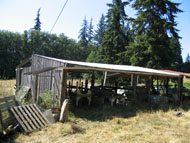

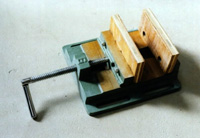
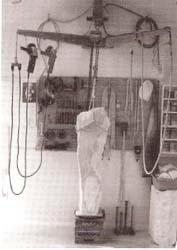
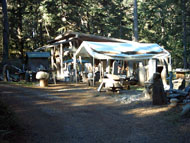
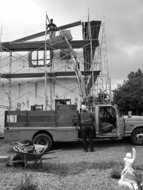

We need some kind of descriptive text here.